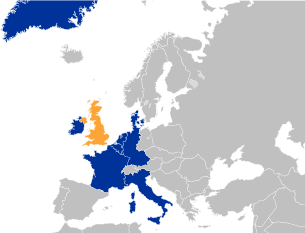European Union Referendum Act 2015
The European Union Referendum Act 2015 (c. 36) is an Act of the Parliament of the United Kingdom that made legal provision for a consultative referendum to be held in the United Kingdom and Gibraltar, on whether it should remain a member state of the European Union or leave it.[1][2] The Bill was introduced to the House of Commons by Philip Hammond, Foreign Secretary on 28 May 2015.[3] Two weeks later, the second reading of the Bill was supported by MPs from all parties except the SNP;[4] the Bill subsequently passed on its third reading in the Commons on 7 September 2015.[5] It was approved by the House of Lords on 14 December 2015,[6] and given Royal Assent on 17 December 2015. The Act came partly into force on the same day and came into full legal force on 1 February 2016.
| Act of Parliament | |
.svg.png) | |
| Long title | An Act to make provision for the holding of a referendum in the United Kingdom and Gibraltar on whether the United Kingdom should remain a member of the European Union. |
|---|---|
| Citation | 2015 c. 36 |
| Introduced by | Philip Hammond, Foreign Secretary (Commons) Joyce Anelay, Baroness Anelay of St Johns, Minister of State for Foreign and Commonwealth Affairs (Lords) |
| Territorial extent | United Kingdom Gibraltar (implemented in Gibraltar by the European Union (Referendum) Act 2016 (Gibraltar)) |
| Dates | |
| Royal assent | 17 December 2015 |
| Commencement |
|
| Other legislation | |
| Relates to | |
Status: Spent | |
| History of passage through Parliament | |
| Text of statute as originally enacted | |
| Revised text of statute as amended | |
| Part of a series of articles on | ||||||||||
| British membership of the European Union | ||||||||||
|---|---|---|---|---|---|---|---|---|---|---|
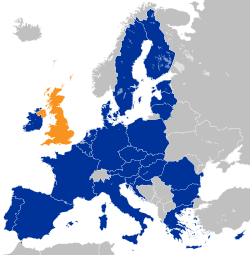 | ||||||||||
|
Treaty amendments
|
||||||||||
|
|
||||||||||
|
Officials and bodies |
||||||||||
|
| ||||||||||

The Act gave effect to a manifesto commitment of the Conservative Party at the general election of May 2015, and was one of the most significant pieces of legislation that were passed by the 2015–17 Parliament. It required the Secretary of State to appoint the day on which the referendum should be held, although it could not be any later than 31 December 2017 and, on 20 February 2016, David Cameron announced that the referendum would take place on 23 June 2016. In the referendum, the electorate voted by 51.9% to 48.1% in favour of leaving the EU, on a 72% turnout.
Origin
On 1 January 1973, the United Kingdom and Gibraltar joined what was then known as the European Communities, under terms negotiated by the then Conservative Prime Minister Edward Heath.[7] In accordance with British constitutional convention, specifically that of parliamentary sovereignty, accession was not subject to approval by referendum. Both the Conservative Party and the Labour Party were divided over the issue, and the European Communities Act 1972 was passed due to sufficient Labour abstentions to counteract the number of rebel Tories.[8] In the run-up to the February 1974 general election, the Labour Party manifesto promised a referendum "on renegotiated terms", which its leader Harold Wilson hoped would end the division of his party.[8] However, the election proved indecisive, and marked the end of Heath's premiership as Prime Minister; Wilson became PM, and called a second election later in the year. After the October 1974 general election, the Labour Party formed a minority administration and held the referendum on continued membership the following year, which was approved by 67% of voters.
For a few years the issue was largely settled but, with the approval by Parliament of the Single European Act, the Maastricht Treaty and the Lisbon Treaty, there were calls from eurosceptic Members of Parliament for a new UK referendum on continued membership. Conservative Party leader David Cameron announced in January 2013, in what became known as "The Bloomberg speech",[9] a proposal to undertake a renegotiation of the terms of the UK's membership of the EU, and subsequently to hold a UK referendum on its membership of the Union. However, at the time of Cameron's speech, the Conservative Party was in Coalition government with the Liberal Democrats who, along with the Labour Party, were at the time opposed to any new referendum being held. The Conservative Party did not have an overall majority and a private member's bill by Conservative MP James Wharton to legislate an in-out referendum by the end of 2017 was blocked in the House of Lords. The proposals were contained in the Conservative Party manifesto for the 2015 United Kingdom general election; the Labour and LibDem parties had also made manifesto commitments to an EU referendum. On the Bill's second reading, on 9 June 2015, MPs voted by 544 to 53 in favour of the principle of holding a referendum with only the Scottish National Party opposing the Bill,[10] and by 316 votes to 53 on its third reading in the Commons on 7 September 2015.[5]
The Act
The Act legislated for a referendum to be held in the United Kingdom and Gibraltar on whether to remain a member of the EU, to be conducted by the Electoral Commission and overseen by an appointed "Chief Counting Officer" (CCO) and a "deputy chief counting officer" (DCCO) who declared the final result for the United Kingdom. By regulation the Act ordered the Secretary of State (in this case the Prime Minister) to appoint a date for the holding of the referendum, as long as the date was no later than 31 December 2017, and not on 5 May 2016 or 4 May 2017. The Electoral Commission is the public body under the terms of the Political Parties, Elections and Referendums Act 2000 that was given the task to raise public awareness ahead of polling day, and to oversee the conduct of the referendum.
The referendum
Limitation
This Act required a referendum to be held on the question of the UK's continued membership of the European Union before the end of 2017. The Bill did not contain any requirement for the UK Government to implement the results of the referendum, nor set a time limit by which a vote to leave the EU should be implemented. Instead, this was a type of referendum known as a pre-legislative or consultative referendum, which enables the electorate to voice an opinion which then influences the Government in its policy decisions. The referendums held in Scotland (1997), Wales (1997) and Northern Ireland (1998) are examples of this type, where opinion was tested before legislation was introduced. The UK does not have constitutional provisions which would require the results of a referendum to be implemented, unlike, for example, the Republic of Ireland, where the circumstances in which a binding referendum should be held are set out in its constitution.
In contrast, the legislation which provided for the referendum held on AV in May 2011 would have implemented the new system of voting without further legislation, provided that the boundary changes also provided for in the Parliamentary Voting System and Constituencies Act 2011 were also implemented. In the event, there was a substantial majority against any change. The 1975 referendum was held after the re-negotiated terms of the UK's EC membership had been agreed by all EC Member States and the terms set out in a command paper which later became known as the Referendum Act 1975 and was passed by both Houses.[11]
The Bill became law when it received Royal Assent on 15 December 2015.
In accordance with the Act and the public duty of the Electoral Commission, a guide was posted to every household in the UK and Gibraltar in the week beginning of 16 May 2016 by HM Government. The leaflet was titled: "Why the Government believes that voting to remain in the European Union is the best decision for the UK". This leaflet stated: "This is your decision. The government will implement what you decide".[12]
Campaign period
The Act legislated that the official referendum campaign period up until polling day would be of ten weeks' duration (which in the event ran from 15 April to 23 June 2016), with an official "purdah" period lasting four weeks (in the event running from 27 May until polling day) during which all government and public bodies were not permitted to comment or publish information specifically related to the subject of the referendum.
Campaign groups spending
Under this Act and the Political Parties, Elections and Referendums Act 2000, the Electoral Commission had the authority to designate and to provide funding for two official lead campaign groups, one for "Remain" and one for "Leave". Each designated group had access to grants worth up to £600,000 as well as television spots and free leaflet drops. The Act declared that these designated groups were not permitted to spend overall more than £7 million. The Act permitted other registered campaign groups to participate but that their overall spending was limited to a maximum of £700,000. Spending by unregistered groups was limited by the Act to a maximum of £10,000. The Electoral Commission announced the official "Remain" and "Leave" designated groups before the beginning of the official campaign period (on 13 April 2016) ahead of the deadline on 14 April 2016: Britain Stronger in Europe for "Remain" and Vote Leave for "Leave".
Political parties spending
Under the Act and the Political Parties, Elections and Referendums Act 2000, political parties were permitted to provide funding for the referendum, although their spending was limited according to their performance at the 2015 general election and, under the rules, the political parties were limited to the maximum of each amount as follows:
- Conservative Party £7 million
- Labour Party £5.5 million
- UKIP £4 million
- Liberal Democrats £3 million
- SNP £700,000
All other political parties who received less than 5% of the national vote share had their maximum spending limited to no more than £700,000.
Individual spending
Unless individuals are officially registered with the Electoral Commission, the maximum limit for spending in the referendum was to be no more than £10,000.[13]
Referendum question
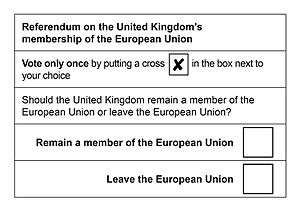
The question that appeared on ballot papers in the referendum before the electorate under the Act was (in English):
Should the United Kingdom remain a member of the European Union or leave the European Union?
with the responses to the question to be marked with a single (X):
Remain a member of the European Union
Leave the European Union
and in Welsh:
A ddylai'r Deyrnas Unedig aros yn aelod o'r Undeb Ewropeaidd neu adael yr Undeb Ewropeaidd?
with the responses (to be marked with a single (X)):
Aros yn aelod o'r Undeb Ewropeaidd
Gadael yr Undeb Ewropeaidd
Original proposed question
Originally the Bill set out the question that was to appear on ballot papers as:
Should the United Kingdom remain a member of the European Union?
and in Welsh:
A ddylai'r Deyrnas Unedig aros yn aelod o'r Undeb Ewropeaidd?
permitting a simple YES/NO answer.
The original proposed question was similar to the question voters were asked in the original 1975 EC membership referendum. However, during subsequent research by the Electoral Commission found that "members of the public feel the wording was not balanced and there was a perception of bias" and proposed a change in the wording of the question. The proposed change was accepted by the government in September 2015, shortly before the Bill's third reading.[14] [15]
Voting areas

Under the provisions of the Act, the designation of a "voting area" (also known by some as "Counting areas") on the day of the referendum was to be overseen by "Counting officers" (CO) who were to declare the results of their local areas within the United Kingdom and Gibraltar as follows:
- A district in England for which there is a district council
- A county in England in which there are no districts with councils (Unitary authority)
- A London borough
- The City of London (including the Inner and Middle Temples)
- The Isles of Scilly
- A county or county borough in Wales
- A local government area in Scotland
- Northern Ireland
- Gibraltar
There were a total of 382 voting areas. 326 in England, 32 in Scotland, 22 in Wales and single areas for Northern Ireland and Gibraltar. The local counts in the voting areas began from 2200 BST (Western European Summer Time) on Thursday 23 June 2016 after all polling stations had closed. Recounts within "voting areas" were permitted when circumstances require under the instructions of the "Counting officers (CO)." It was the first time that a United Kingdom referendum was counted overnight as both the previous 1975 EC Referendum and the 2011 AV Referendum were counted during the course of the following day after polling stations closed.
Regional counts
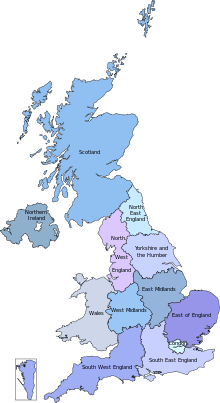
The Act also provided provision for the results from the "voting areas" to fed into twelve "regional counts" to be overseen by "Regional counting officers" (RCO) who were appointed in the following areas and declared the results for their areas as used under the European Parliamentary Elections Act 2002:
- East Midlands (40 voting areas)
- East of England (47 voting areas)
- Greater London (33 voting areas)
- Northern Ireland (1 voting area)
- North East England (12 voting areas)
- North West England (39 voting areas)
- Scotland (32 voting areas)
- South East England (67 voting areas)
- South West England (also including Gibraltar) (38 voting areas)
- Yorkshire and the Humber (21 voting areas)
- Wales (22 voting areas)
- West Midlands (30 voting areas)
For the purposes of the referendum, the local result from Gibraltar was fed into the South West England regional count. The regions each declared their results once all local voting areas had declared their local results early on Friday 24 June 2016. There was no provision under the Act for any national or regional recounts by the Chief Counting Officer and Regional Counting Officers.
Franchise
The right to vote in the referendum applied to UK and Gibraltar residents who are British, Irish and Commonwealth citizens, in accordance with the provisions of the Representation of the People Act 1983 and the Representation of the People Act 2000. Members of the House of Lords were able to vote in the referendum. Citizens of other EU countries resident in the UK were not allowed to vote unless they were citizens of the Republic of Ireland, Malta or Cyprus. The same Acts permitted UK nationals who had lived overseas for less than 15 years to vote.[16] Voting on the day of the referendum was from 07:00 to 22:00 BST ([Western European Summer Time) (07:00 to 22:00 Central European Summer Time in Gibraltar) in some 41,000 polling stations staffed by over 100,000 officials. Each polling station was specified to have no more than 2,500 registered voters.[17] Also under the provisions of the Representation of the People Act 2000 postal ballots were also permitted in the referendum and were sent out to eligible voters some three weeks ahead of the vote (2 June 2016). Residents of the Isle of Man, and the other Crown Dependencies Jersey and Guernsey, were not be eligible to vote in the referendum, as those territories are not part of the UK [nor of the EU].[18]
The minimum age for voters in the referendum was 18 years, in accordance with Representation Acts (above). A House of Lords amendment proposing to lower the minimum age to 16 years[19] was rejected.[6]
Calling of referendum
On the morning of Saturday 20 February 2016 Prime Minister David Cameron held a special cabinet meeting in 10 Downing Street with his fellow Ministers (the first such meeting to be held on a Saturday since 3 April 1982 at the start of the Falklands War). After the meeting, he announced outside the door of No 10 that the referendum would be held on Thursday 23 June 2016. On Monday 22 February 2016, Parliament enacted secondary legislation to authorise the holding of the referendum on that date.[20]
Eligible voters
On Tuesday 21 June 2016, the Electoral Commission announced the provisional official number of eligible voters who were entitled to vote in the referendum on Thursday 23 June in each of the constituent countries of the United Kingdom and Gibraltar following the closing date for registration on Thursday 9 June 2016 (these figures include all Commonwealth and Irish citizens along with members of the House of Lords who are not normally eligible to vote in UK general elections).[21] The final number of eligible voters was published after 9 pm on Thursday 23 June 2016 by the Electoral Commission.[22]
The following shows both the provisional figures and the final figures in heavy bold brackets.
| Country | Eligible voters |
|---|---|
| United Kingdom (together with Gibraltar) |
46,499,537 (46,500,001) |
| Country | Eligible voters |
|---|---|
| United Kingdom | 46,475,420 (46,475,882) |
| Gibraltar | 24,117 (24,119) |
English regions (together with Gibraltar)
| English regions (together with Gibraltar) |
Eligible voters |
|---|---|
| East Midlands | 3,385,057 (3,384,299) |
| East of England | 4,398,430 (4,398,796) |
| London | 5,424,289 (5,424,768) |
| North East England | 1,934,228 (1,934,341) |
| North West England | 5,237,900 (5,241,568) |
| South East England | 6,472,915 (6,465,404) |
| South West England (together with Gibraltar) |
4,138,015 (4,138,134) |
| West Midlands | 4,116,199 (4,116,572) |
| Yorkshire and the Humber | 3,873,908 (3,877,780) |
Constituent countries
| Constituent countries | Eligible voters |
|---|---|
| England (including Gibraltar) |
38,980,941 (39,005,781) |
| Northern Ireland | 1,260,955 (1,260,955) |
| Scotland | 3,988,492 (3,987,112) |
| Wales | 2,270,743 (2,270,272) |
| Constituent countries | Eligible voters |
|---|---|
| England (excluding Gibraltar) |
38,956,824 (38,981,662) |
| Northern Ireland | 1,260,955 (1,260,955) |
| Scotland | 3,988,492 (3,987,112) |
| Wales | 2,270,743 (2,270,272) |
Referendum result
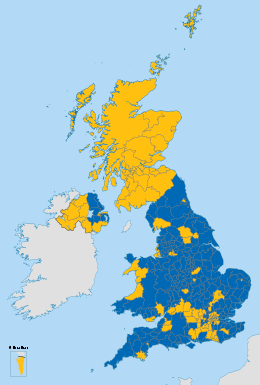
The result was declared by Chief counting officer (CCO) and the then chair of the Electoral Commission Jenny Watson at Manchester Town Hall on Friday 24 June 2016 at 0720 BST after all 382 voting areas and the 12 regions of the United Kingdom had all declared their results. Of the voting areas a total of 263 returned majority votes in favour of leaving the European Union whilst 119 returned majority votes in favour of continued European Union membership including every council area within Scotland on a national turnout of 72% and in the voting regions Scotland, Northern Ireland and Greater London voted to remain whilst all other regions including Wales voted to leave.
| United Kingdom European Union membership referendum, 2016 National result | |||
| Choice | Votes | % | |
|---|---|---|---|
| Leave the European Union | 17,410,742 | 51.89% | |
| Remain a member of the European Union | 16,141,241 | 48.11% | |
| Valid votes | 33,551,983 | 99.92% | |
| Invalid or blank votes | 25,359 | 0.08% | |
| Total votes | 33,577,342 | 100.00% | |
| Registered voters and turnout | 46,500,001 | 72.21% | |
| Voting age population and turnout | 51,356,768 | 65.38% | |
| Source: Electoral Commission | |||
| Leave: 17,410,742 (51.9%) |
Remain: 16,141,241 (48.1%) | ||
| ▲ | |||
Results by United Kingdom regions
| Region | Electorate | Voter turnout, of eligible |
Votes | Proportion of votes | |||
|---|---|---|---|---|---|---|---|
| Remain | Leave | Remain | Leave | ||||
| East Midlands | 3,384,299 | 74.2% | 1,033,036 | 1,475,479 | 41.18% | 58.82% | |
| East of England | 4,398,796 | 75.7% | 1,448,616 | 1,880,367 | 43.52% | 56.48% | |
| Greater London | 5,424,768 | 69.7% | 2,263,519 | 1,513,232 | 59.93% | 40.07% | |
| North East England | 1,934,341 | 69.3% | 562,595 | 778,103 | 41.96% | 58.04% | |
| North West England | 5,241,568 | 70.0% | 1,699,020 | 1,966,925 | 46.35% | 53.65% | |
| Northern Ireland | 1,260,955 | 62.7% | 440,707 | 349,442 | 55.78% | 44.22% | |
| Scotland | 3,987,112 | 67.2% | 1,661,191 | 1,018,322 | 62.00% | 38.00% | |
| South East England | 6,465,404 | 76.8% | 2,391,718 | 2,567,965 | 48.22% | 51.78% | |
| South West England (together with Gibraltar) |
4,138,134 | 76.7% | 1,503,019 | 1,669,711 | 47.37% | 52.63% | |
| Wales | 2,270,272 | 71.7% | 772,347 | 854,572 | 47.47% | 52.53% | |
| West Midlands | 4,116,572 | 72.0% | 1,207,175 | 1,755,687 | 40.74% | 59.26% | |
| Yorkshire and the Humber | 3,877,780 | 70.7% | 1,158,298 | 1,580,937 | 42.29% | 57.71% | |
Results by United Kingdom constituent countries
| Country | Electorate | Voter turnout, of eligible |
Votes | Proportion of votes | |||
|---|---|---|---|---|---|---|---|
| Remain | Leave | Remain | Leave | ||||
| England (including Gibraltar) |
39,005,781 | 73.0% | 13,266,996 | 15,188,406 | 46.62% | 53.38% | |
| Northern Ireland | 1,260,955 | 62.7% | 440,707 | 349,442 | 55.78% | 44.22% | |
| Scotland | 3,987,112 | 67.2% | 1,661,191 | 1,018,322 | 62.00% | 38.00% | |
| Wales | 2,270,272 | 71.7% | 772,347 | 854,572 | 47.47% | 52.53% | |
Legislative consequences
The Act made no provision for the result to be legally binding on the government or on any future government; legally it was merely advisory.[23] The result of the referendum required a single majority vote of the United Kingdom and Gibraltar with no super majorities, no double majorities of the constituent countries, nor any minimum turnout threshold required for the vote to pass. The Act did not specify any specific consequences that would follow the result of the referendum. In the event of a "Leave" vote, it was expected that the government would decide whether, when, and under what circumstances, the UK would invoke Article 50 of the Treaty on European Union to begin a two-year process of negotiations for Britain to leave the EU. Since the Act was also silent on the question of executive prerogative, the question of whether the government or Parliament was entitled to invoke Article 50 was the subject of court proceedings (Miller's case). James Eadie QC, acting for the government, submitted in his address to the court that, because the Act is silent, it would imply that Parliament chose not to limit prerogative powers in this matter.[24] On 3 November 2016, the High Court in London ruled that it is the responsibility of Parliament (and not of the Government unilaterally) to decide whether, when, and how the UK should set aside legislation (in this case, the European Communities Act 1972 that makes the UK a member of the EU). The court held that the referendum was "advisory for the lawmakers in Parliament", enabling the electorate to influence Parliament in its policy decisions. In interpreting the intent of the Act, the court considered the precedents of previous UK referendums. As a consequence, the European Union (Notification of Withdrawal) Bill 2017 was introduced into Parliament to gain Parliament's consent for the invocation of Article 50. European Union law remains enforceable in the United Kingdom until or unless the European Communities Act 1972 is repealed.[17] In October 2016, Theresa May promised a "Great Repeal Bill", which would repeal the European Communities Act and restate in UK law all enactments previously in force under EU law. This bill was expected to be introduced in the May 2017 parliamentary session and enacted before or during the Article 50 negotiations. It would not come into force until the date of exit. It would smooth the transition by ensuring that all laws remain in force until specifically repealed.[25] This ultimately became the European Union (Withdrawal) Act 2018.
Outcome
Following the referendum result and the verdict of the R (Miller) v Secretary of State for Exiting the European Union case in January 2017 the UK Government led by Prime Minister Theresa May passed the European Union (Notification of Withdrawal) Act 2017 which legally allowed the UK to formally begin the process and formally notified the European Union of the United Kingdom's intention to leave both the European Union and the European Atomic Energy Community by triggering Article 50 of the Treaty on European Union on Wednesday 29 March 2017.
See also
- Aftermath of the 2016 United Kingdom European Union membership referendum
- Acts of Parliament of the United Kingdom relating to the European Communities and the European Union
- R (Miller) v Secretary of State for Exiting the European Union
- European Union (Referendum) Bill 2013
- European Communities Act 1972 (UK)
- European Economic Area Act 1993
- Referendum Act 1975
- 1975 United Kingdom European Communities membership referendum
- Withdrawal from the European Union
- United Kingdom withdrawal from the European Union
- Euroscepticism
- Euroscepticism in the United Kingdom
- European Parliamentary Elections Act 2002
- European Union (Amendment) Act 2008
- 2015–16 United Kingdom renegotiation of European Union membership
- Vote Leave
- Labour Leave
- Leave.EU
- Britain Stronger in Europe
- Labour in for Britain
- European Union (Notification of Withdrawal) Act 2017
- United Kingdom invocation of Article 50 of the Treaty on European Union
- Bloomberg speech
References
- European Union Referendum Act 2015 in BAILII.
- David Allen Green (14 June 2016). "Can the United Kingdom government legally disregard a vote for Brexit?". Financial Times. Retrieved 26 June 2016.
- "European Union Referendum Bill 2015–16". Parliament of the United Kingdom. Retrieved 8 September 2015.
- "European Union Referendum Bill — Second Reading — 9 Jun 2015 at 19:36". www.publicwhip.org.uk. Retrieved 23 March 2019.
- "The Public Whip — European Union Referendum Bill — Third Reading - 7 Sep 2015 at 24:28". www.publicwhip.org.uk. Retrieved 2 February 2019.
- Dathan, Matt (15 December 2015). "EU referendum outcome on a knife edge, new poll reveals". The Independent. Retrieved 16 December 2015.
- Timeline: Campaigns for a European Union referendum – BBC 21 May 2015
- BBC TV programme "Europe: Them Or Us: An Island Apart" – BBC, 12 April 2016
- Cameron, David. "EU speech at Bloomberg". GOV.UK.
- "EU referendum: MPs support plan for say on Europe". BBC News. 9 June 2015. Retrieved 7 April 2016.
- House of Commons Library BRIEFING PAPER Number 07212, 3 June 2015. This content is released under the Open Parliament Licence v3.0.
- "Why the government believes that voting to remain in the EU is the best decision for the UK". Cabinet Office. 6 April 2016. Retrieved 8 November 2016.
- "Non-party campaigners: Guidance for the referendum on the United Kingdom's membership of the European Union: Factsheet: The EU referendum rules – how your organisations activities might be affected (PDF)" (PDF). The Electoral Commission. 11 June 2015. Retrieved 14 May 2016.
Any individual or organisation can spend up to £10,000 on referendum spending. You must not spend more than £10,000 on referendum spending during the referendum period unless you have registered with us as a "registered campaigner". If you do, you may commit an offence.
- Watt, Nicholas; Syal, Rajeev (1 September 2015). "EU referendum: Cameron accepts advice to change wording of question". The Guardian. Retrieved 13 September 2015.
- "Three years since the Brexit vote, meet the man behind Leave and Remain". Retrieved 25 June 2019.
- "Background to the UK's EU referendum 2016". Retrieved 28 June 2016.
- "A guide to the UK's planned in-out EU referendum". BBC News. 2 September 2015. Retrieved 8 September 2015.
- "Lord of the Rings star launches Manx EU referendum petition". BBC News. 29 January 2016. Retrieved 15 February 2016.
- Waugh, Paul (6 November 2015). "Labour Lords Table Fresh Move To Give 16 and 17-Year-Olds The Vote in the EU Referendum". The Huffington Post. Retrieved 11 November 2015.
- "EU referendum: Cameron sets June date for UK vote". BBC News.
- "Provisional electorate figures published ahead of the EU referendum". Retrieved 21 June 2016.
- "EU Referendum results". Retrieved 13 July 2016.
- Owen Bowcott (11 July 2016). "Parliament should make final decision on whether to leave EU, barristers say". The Guardian. Retrieved 11 July 2016.
- Green, David Allen (17 June 2016). "David Cameron's unnecessary EU referendum". Financial Times. Retrieved 18 June 2016.
- Mason, Rowena (2 October 2016). "Theresa May's 'great repeal bill': what's going to happen and when?". The Guardian. Retrieved 3 October 2016.
